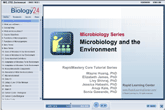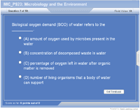| How to Learn in 24 Hours? |
|
| Need Help? |
M-F: 9am-5pm(PST):
Toll-Free: (877) RAPID-10
or 1-877-727-4310
24/7 Online Technical Support:
The Rapid Support Center
vip@rapidlearningcenter.com
Secure Online Order:

|
| Tell-A-Friend: |
Have friends taking science and math courses too? Tell them about our rapid learning system.
|
|
Microbiology and the Environment
| Topic Review on "Title": |
Microorganisms in Ecosystems:
- An ecosystem is an area of nature that includes biotic and abiotic components. These components have processes that make up and define a certain section of the environment. The biotic and abiotic components are linked by nutrient cycling and the flow of energy.
- Microorganisms in the ecosystem decompose organic substrates called mineralization and are a source of food for some chemoheterotrophic microbes.
- Some organisms produce antimicrobial substances such as antibiotics.
- Adaptations of a microbe to its environment can include modifying its metabolism to optimize its survival in a given place.
- Fungi play an important role in decomposition of organic matter.
- Algae are very important in converting atmospheric CO2 into organic matter.
- Protozoan have adapted the ability to move and acquire digestible organic food.
- Bacteria and Archaea are involved in virtually all the cycles of essential elements.
- Ecosystem and its components: Abiotic Substances, Producers, Consumers, Decomposers.
- Ecosystems consist of: living organisms which interact with inanimate substances, other organisms and each other resulting in changes in the abiotic environment. The interactions of organisms is called ecology.
- Microenvironment is a subset of the larger ecosystem. It is characterized by the presence of overlapping gradients of resources, toxic material and limiting factors.
- The most important aspect of microbes on their environment is the ability to recycle essential elements that make up cells.
Essential Cycles
- Biogeochemical cycle – is chemical interactions between the atmosphere, lithosphere, hydrosphere and biosphere.
- Recycling of elements (CHONSP)
- Essential elements must be converted from one form to another.
- Microbial cells are crucial to the transformation of these elements.
- The elements include, carbon, hydrogen, oxygen, nitrogen, sulfur and phosphorus.
- Carbon Cycle Geological
- CO2 in the atmosphere is recycles via the oceans and land.
- Carbon Cycle – Biological
- The combined processes of photosynthesis, decomposition, and respiration in which carbon is recycled.
- Sulfur Cycle
- The process were by sulfur that is a part of organic molecules, as in proteins, are reduced by fungi or bacteria.
- The reduced H2S is then oxidized the H2S and lithotrophic bacteria further oxidizes it to SO4.
- Plants and bacteria then incorporate it into organic molecules.
- Phosphorus Cycle
- Phosphorus cycle is a biogeochemical cycle in which the atmosphere does not play a significant role in its movements.
- Plants absorb phosphates from the soil and can then be eaten herbivores that may then be eaten by carnivores. Upon death the animal or plant will decay and the phosphate is returned to the soli.
- Phosphates are important components of nucleotides, energy storage molecules such as ATP, bones and phospholipids.
- Iron Cycle
- Is a biogeochemical cycle through landforms, atmosphere and oceans.
- Bacteria such as Pseudomonas and Thiobacillus ferroxidan can reduce and oxidize (respectively) iron to make it bioavailable.
- Nitrogen Cycle
- Nitrogen exists in the atmosphere as a gas (mostly N2).
- Nitrogen is often a limiting nutrient for plant growth.
- Atmospheric nitrogen become a part of biological matter primarily by the actions of bacteria and algae in a process called nitrogen fixation.
- Nitrogen fixing bacteria form nodules on the roots of legumes and take nitrogen from the air and convert it into ammonia NH3. The NH3 is further converted by other bacteria into NO2- and then into NO3-. Plants use the nitrate ion as a nutrient or fertilizer to grow.
- Nitrogen is incorporated into amino acids.
Definitions
- Microenvironment: small spaces deep in the earth with varying environmental factors.
- Food Chain is a series of organisms each feeding on a preceding one.
- Food Web a complex interlocking series of food chains.
- Liebig’s Law of the Minimum: this principle says that the growth of organisms is not controlled by the total amount of resources available but rather by the least or scarcest resource.
- Biogeochemical cycling is the cycling of essential elements by microbes.
- Nitrification is the process were by ammonia NH4+ is oxidize to (NO3-) by autotrophic bacteria.
- Habitat is the physical place that an organism lives.
- Niche the habitat and biological adaptations an organism posses to live.
- Population – the number of like organisms in a place at any given time.
- Community – a collection of organisms of different species that interact with each other.
- Biological Oxygen Demand: BOD is an indirect measure of organic matter in an aquatic environment. The amount of dissolved oxygen needed for microbial oxidation of biodegradable organic matter. BOD levels in sewage and waste water have been set.
- Bioremediation is the use of microorganisms to clean up an environment. By chemotaxis and other mechanisms microbes move around environments that have the contaminate that is broken down or recycled.
|
| Rapid Study Kit for "Title": |
| Flash Movie |
Flash Game |
Flash Card |
| Core Concept Tutorial |
Problem Solving Drill |
Review Cheat Sheet |
 |
 |
 |
|
| "Title" Tutorial Summary : |
Microorganisms are critical components of the biosphere. They assist in recycling essential elements and making them biologically available to be used by other organisms. They are involved in a process known as bioremediation in which microbes are used to break down contaminates and pollutants in order to clean and replenish a particular environment.
In addition to microbes use in recycling nutrients they are themselves a significant source of nutrients. They are a important part of the food chain in the ecosystem.
|
| Tutorial Features: |
Specific Tutorial Features:
- Definitions of relevant aspects of microbiology as it relates to the environment.
- Microorganisms and their role in the environment.
- Interactions between microbes and other species.
- Microbial nutrient cycle also known as the biogeochemical cycle.
Series Features:
- Definition slides introduce terms as they are needed.
- Examples given throughout to illustrate how the concepts apply.
- Focus questions to highlight the objectives of the tutorial.
- A concise summary is given at the conclusion of the tutorial.
|
| "Title" Topic List: |
To understand the role of microbes and their interaction with their environment.
Appreciate the role microbes play in the maintenance of healthy ecosystem.
Gain an awareness for the role of microbes in their interaction with each other.
Microorganisms are essential in cycling of critical nutrients such as nitrogen, oxygen, phosphate, iron and sulfur.
They are part of the food chain.
Used in bioremediation and environmental clean up.
|
See all 24 lessons in Anatomy and Physiology, including concept tutorials, problem drills and cheat sheets:
Teach Yourself Microbiology Visually in 24 Hours
|



